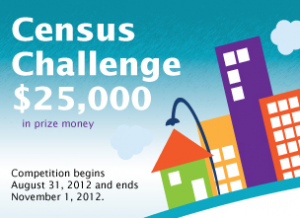Written by: Tom Mesenbourg, Acting Director
We could not produce statistics about our nation’s people, places and economy without your help. Your participation in our surveys gives us the information that tells us how we are doing as a nation. And in turn, we are able to paint a portrait of not only our nation, but your community.
Your participation is vital to the data we collect. But we also know you have a lot of great ideas to make us a better, more efficient agency that will continue to produce high-quality statistics.
We want to tap into those great ideas and have created the first Census challenge—to find a better way to predict mail return rates for small geographic areas, like neighborhoods, based on their demographic and socioeconomic characteristics. This prize competition is authorized under Section 105 of the America COMPETES Reauthorization Act of 2011, Public Law 111-358 (2011).
The 2010 Census achieved a return rate of 79.3 percent, which was the rate of returned forms for all occupied housing units. However, census and survey return rates vary considerably across geographic areas. For example, 2010 Census mail-form return rates ranged across states from a high of 82 percent to a low of 65 percent, with even more variation at the neighborhood or census tract level. The Census Return Rate Challenge asks participants to model these variations using predictive variables found in the updated Census Planning Database which includes information from both the 2010 Census and the American Community Survey.
During the 2010 Census, the Census Bureau saved about $85 million in operational costs for every percentage point increase in the nation’s participation rate by mail. A postage paid envelope cost taxpayers 42 cents, compared to $57 for an enumerator to visit the household. The winning model will help us develop more efficient and effective data collection strategies for both our ongoing household surveys and the 2020 Census.
We are posting the challenge on <www.kaggle.com>, an online platform for predictive modeling competitions. Already, there are 86 teams, 98 participants and 533 entries, allowing us to crowdsource the best solution for how to tackle this challenge.
There is still time to participate. The challenge ends Nov. 1, 2012. Not only do participants get to challenge themselves, they could be rewarded for it. A total of $25,000 in prize money will be awarded for the best submissions.
This challenge is just one way the Census Bureau is changing how we do business, allowing you to be an engine of innovation. I am excited about the initiatives we currently have underway that promise to transform our methods, processes, and products and I hope you will help us, by entering the competition today.
For more information, please visit the Federal Register Notice and Census Bureau Research site.







Explain difference in cost to all and how it effects their community”payback” if they are not counted.
Set up volunteer captains by block, by building or whatever geography is logical for encouraging participation.
This is a great effort and need! Is it possible to tie completion of your survey to signing onto our personal computer ISPs? You could allow 3-4 sign-ons to be completed with a pop-up message, before the 4th or 5th would require completion of the form prior to allowing full ISP connection to do other activities.
Similarly tieing census completion to receipt of unemployment, welfare benefits, incorporation or renewal, filing of IRS taxes and payments should get you much closer to your goal.
I’m not entering this competition but I have one important observation, that cost the Town of Bourne, MA enough population to put it under 20,000 in 2010 whereas the Town census has found >20,000 for several years now. The Post Office does not deliver mail to many physical addresses in Bourne. Those households have to have PO boxes and there is no way the Census can mail to their physical address. End runs around this problem were attempted for 2010 but relied on voluntary pickup of census forms. I don’t know the solution to this but it is a big problem.
Census by mail not only would cost less, it would prove to be more accurate. My team worked hard during the 2010 census and visited EVERY location assigned to them.l When the work was complete, we heard that there were teams that utilized internet information to complete their forms. Therefore the overall census could not have been “completely accurate”.
Suggestion: Mail census forms to everyone possible. For those who cannot be reached by mail, establish a “census assistance location” that individuals can go to to complete their forms. This would require significantly less people in each community to assist and oversee submission. Tie the census to receipt of welfare, social security, etc. and the people will make sure they complete and submit their information. For those not on government assistance, tie completion/submission to filing income tax.
I was grateful for the opportunity to participate in the 2010 census, but know firsthand the cost of that endeavor.
Use county tax records to identify all country property addresses.